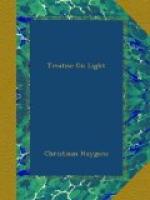And this same thing is the cause why at certain times a distant object will be hidden behind another less distant one, and yet may at another time be able to be seen, although the spot from which it is viewed is always the same. But the reason for this effect will be still more evident from what we are going to remark touching the curvature of rays. It appears from the things explained above that the progression or propagation of a small part of a wave of light is properly what one calls a ray. Now these rays, instead of being straight as they are in homogeneous media, ought to be curved in an atmosphere of unequal penetrability. For they necessarily follow from the object to the eye the line which intersects at right angles all the progressions of the waves, as in the first figure the line AEB does, as will be shown hereafter; and it is this line which determines what interposed bodies would or would not hinder us from seeing the object. For although the point of the steeple A appears raised to D, it would yet not appear to the eye B if the tower H was between the two, because it crosses the curve AEB. But the tower E, which is beneath this curve, does not hinder the point A from being seen. Now according as the air near the Earth exceeds in density that which is higher, the curvature of the ray AEB becomes greater: so that at certain times it passes above the summit E, which allows the point A to be perceived by the eye at B; and at other times it is intercepted by the same tower E which hides A from this same eye.
[Illustration]
But to demonstrate this curvature of the rays conformably to all our preceding Theory, let us imagine that ab is a small portion of a wave of light coming from the side C, which we may consider as a straight line. Let us also suppose that it is perpendicular to the Horizon, the portion B being nearer to the Earth than the portion A; and that because the vapours are less hindering at A than at B, the particular wave which comes from the point A spreads through a certain space ad while the particular wave which starts from the point B spreads through a shorter space be; ad and be being parallel to the Horizon. Further, supposing the straight lines FG, hi, etc., to be drawn from an infinitude of points




